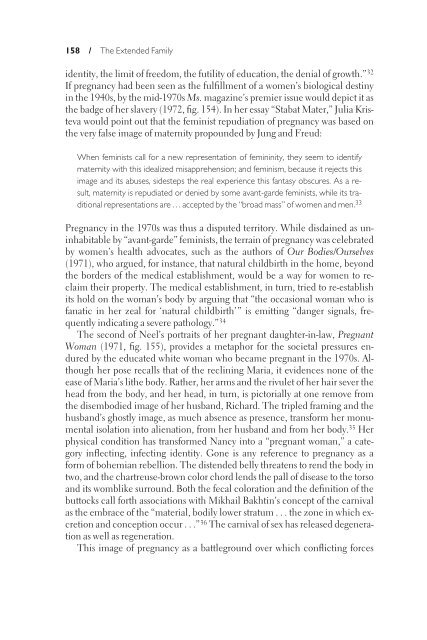i-xxii Front matter.qxd - Brandeis Institutional Repository
i-xxii Front matter.qxd - Brandeis Institutional Repository
i-xxii Front matter.qxd - Brandeis Institutional Repository
You also want an ePaper? Increase the reach of your titles
YUMPU automatically turns print PDFs into web optimized ePapers that Google loves.
158 / The Extended Familyidentity, the limit of freedom, the futility of education, the denial of growth.” 32If pregnancy had been seen as the fulƒllment of a women’s biological destinyin the 1940s, by the mid-1970s Ms. magazine’s premier issue would depict it asthe badge of her slavery (1972, ƒg. 154). In her essay “Stabat Mater,” Julia Kristevawould point out that the feminist repudiation of pregnancy was based onthe very false image of maternity propounded by Jung and Freud:When feminists call for a new representation of femininity, they seem to identifymaternity with this idealized misapprehension; and feminism, because it rejects thisimage and its abuses, sidesteps the real experience this fantasy obscures. As a result,maternity is repudiated or denied by some avant-garde feminists, while its traditionalrepresentations are . . . accepted by the “broad mass” of women and men. 33Pregnancy in the 1970s was thus a disputed territory. While disdained as uninhabitableby “avant-garde” feminists, the terrain of pregnancy was celebratedby women’s health advocates, such as the authors of Our Bodies/Ourselves(1971), who argued, for instance, that natural childbirth in the home, beyondthe borders of the medical establishment, would be a way for women to reclaimtheir property. The medical establishment, in turn, tried to re-establishits hold on the woman’s body by arguing that “the occasional woman who isfanatic in her zeal for ‘natural childbirth’” is emitting “danger signals, frequentlyindicating a severe pathology.” 34The second of Neel’s portraits of her pregnant daughter-in-law, PregnantWoman (1971, ƒg. 155), provides a metaphor for the societal pressures enduredby the educated white woman who became pregnant in the 1970s. Althoughher pose recalls that of the reclining Maria, it evidences none of theease of Maria’s lithe body. Rather, her arms and the rivulet of her hair sever thehead from the body, and her head, in turn, is pictorially at one remove fromthe disembodied image of her husband, Richard. The tripled framing and thehusband’s ghostly image, as much absence as presence, transform her monumentalisolation into alienation, from her husband and from her body. 35 Herphysical condition has transformed Nancy into a “pregnant woman,” a categoryin„ecting, infecting identity. Gone is any reference to pregnancy as aform of bohemian rebellion. The distended belly threatens to rend the body intwo, and the chartreuse-brown color chord lends the pall of disease to the torsoand its womblike surround. Both the fecal coloration and the deƒnition of thebuttocks call forth associations with Mikhail Bakhtin’s concept of the carnivalas the embrace of the “material, bodily lower stratum . . . the zone in which excretionand conception occur...” 36 The carnival of sex has released degenerationas well as regeneration.This image of pregnancy as a battleground over which con„icting forces
















